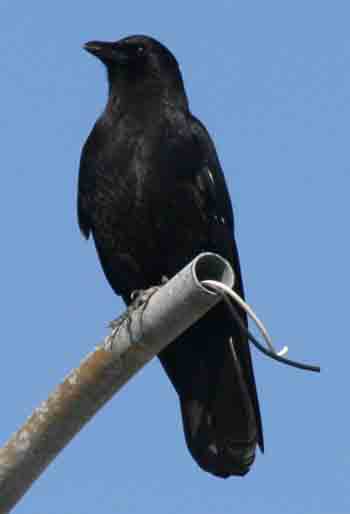American Crow
General: The American Crow (Common Crow) is a common bird found throughout much of North America. They can be spotted in forests, farmland and cities. In the Northeast US I have watched American Crows gather in large communal roosts at night. In the Capital District of upstate New York (Albany, Troy and Rensselaer) 10’s of thousands of these birds roost along the Hudson River in winter. During these roosting periods, it is common to drive just at twilight and see branches of trees totally covered with crows. This scenario is repeated in other towns and areas throughout their range.
 The American Crow is an intelligent and adaptable bird. It is one of only a few species of bird that has been observed modifying and using tools to obtain food.
The American Crow is an intelligent and adaptable bird. It is one of only a few species of bird that has been observed modifying and using tools to obtain food.
They are also an aggressive bird and will protect territory, food and nests from almost all intruders. It is common to see American Crows chase larger birds such as hawks, falcons, owls and herons. I have watched as a mob (that is what a “flock” of crows is called) of crows attack squirrels and mink.
When nesting, both members of a breeding pair help build the nest. They make the nest with twigs with an inner cup lined with pine needles, weeds, soft bark, or animal hair. Nest size is quite variable, typically 6-19 inches across, with an inner cup about 6-14 inches across and 4-15 inches deep. Crows typically hide their nests in a crotch near the trunk of a tree or on a horizontal branch, generally towards the top third or quarter of the tree. They prefer to nest in evergreens, but will nest in deciduous trees when evergreens are less available.
The female lays 3–9 eggs that are 1.4” – 1.9” long 1” – 1.2” wide. The eggs are pale bluish-green to olive green with blotches of brown and gray toward the large end.
American Crows are highly susceptible to the West Nile Virus.
Identification: American Crows are generally 15.7” – 20.9” long with a wingspan of 33.5” – 40.0” and a weight of 11 oz – 22 oz. The American Crow has iridescent black feathers all over. Its legs, feet and bill are also black. They are long-legged, thick-necked with a heavy, straight bill. In flight, the wings are fairly broad and rounded with the wingtip feathers spread like fingers. The short tail is rounded or squared off at the end.
When not sure if you are viewing a crow or raven remember, the American Crow is about two-thirds the size of a Common Raven (Ravens can be almost the size of a Red-tailed Hawk). And Raven tails in flight are wedge shaped.
Habitat: Virtually all types of country from wilderness, farmland, parks, open woodland to towns and cities are inhabited; it is absent only from Pacific temperate rain forests and tundra habitat where it is replaced by the raven.
Territory: The range of the American Crow extends from the Pacific Ocean to the Atlantic Ocean in Canada, on the French islands of Saint-Pierre and Miquelon, south through the United States, and into northern Mexico
Migration: This crow is a permanent resident in most of the USA, but Canadian birds can migrate some distances southward in winter.
Diet: American Crow is omnivorous, usually feeding on the ground and will eat almost anything. It will feed on invertebrates of all types, carrion, scraps of human food, seeds, eggs and nestlings, stranded fish on the shore and various grains. American Crows are active hunters and will prey on mice, frogs, and other small animals. In winter and autumn, the diet of American Crows is more dependent on nuts and acorns. Occasionally, they will visit bird feeders. I often see them along roadsides feeding on road-kill.
I have read that “though their bills are large, crows can’t break through the skin of even a gray squirrel.” I have spent time observing crows feed on a gray squirrel that had been hit by a car two days earlier. They were able to break through the skin of the squirrel.